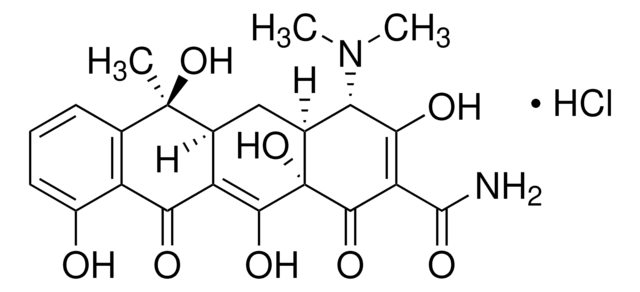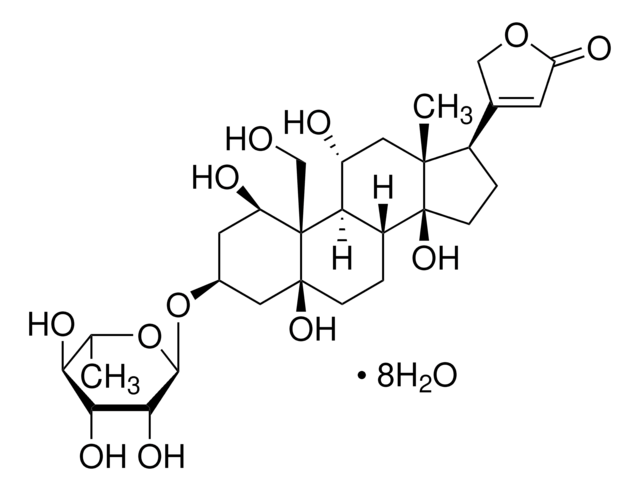G3632
Gentamicina sulfate salt
potency: ≥590 I.U. Gentamicin base per mg
Sinónimos:
GM Sulfate, Gentamicin C
About This Item
Productos recomendados
origen biológico
Micromonospora purpurea
Nivel de calidad
formulario
powder
potencia
≥590 I.U. Gentamicin base per mg
≥590 units/mg Gentamicin
condiciones de almacenamiento
(Tightly closed. Dry. )
concentración
50 μg/mL in H2O (is the recommended working concentration for eukaryotic cell culture)
color
white to off-white
espectro de actividad antibiótica
Gram-negative bacteria
Gram-positive bacteria
mycoplasma
Modo de acción
protein synthesis | interferes
temp. de almacenamiento
2-8°C
cadena SMILES
O=S(O)(O)=O.O[C@]1(C)[C@@H]([C@@H](O)[C@@H](O[C@@H]2[C@@H](O)[C@H](O[C@H]3O[C@@](CC[C@H]3N)([C@@H](C)NC)[H])[C@@H](N)C[C@H]2N)OC1)NC.O[C@]4(C)[C@@H]([C@@H](O)[C@@H](O[C@@H]5[C@@H](O)[C@H](O[C@H]6O[C@@](CC[C@H]6N)([C@@H](C)N)[H])[C@@H](N)C[C@H]5N)OC4)NC.O[
InChI
1S/C21H43N5O7.C20H41N5O7.C19H39N5O7.H2O4S/c1-9(25-3)13-6-5-10(22)19(31-13)32-16-11(23)7-12(24)17(14(16)27)33-20-15(28)18(26-4)21(2,29)8-30-20;1-8(21)12-5-4-9(22)18(30-12)31-15-10(23)6-11(24)16(13(15)26)32-19-14(27)17(25-3)20(2,28)7-29-19;1-19(27)7-28-18(13(26)16(19)24-2)31-15-11(23)5-10(22)14(12(15)25)30-17-9(21)4-3-8(6-20)29-17;1-5(2,3)4/h9-20,25-29H,5-8,22-24H2,1-4H3;8-19,25-28H,4-7,21-24H2,1-3H3;8-18,24-27H,3-7,20-23H2,1-2H3;(H2,1,2,3,4)/t9-,10-,11+,12-,13+,14+,15-,16-,17+,18-,19-,20-,21+;8-,9-,10+,11-,12+,13+,14-,15-,16+,17-,18-,19-,20+;8-,9+,10-,11+,12-,13+,14+,15-,16+,17+,18+,19-;/m110./s1
Clave InChI
RDEIXVOBVLKYNT-HDZPSJEVSA-N
¿Está buscando productos similares? Visita Guía de comparación de productos
Descripción general
Aplicación
- in the research of the effectiveness of antibiotics against different bacterial cultures
- in the research of neuronal signal processing
Acciones bioquímicas o fisiológicas
Espectro antimicrobiano: Incluye bacterias gramnegativas y grampositivas, entre ellas cepas resistentes a la tetraciclina, el cloranfenicol, la canamicina y la colistina, en particular cepas de Pseudomonas, Proteus, Staphylococcus y Streptococcus.
Características y beneficios
Componentes
Almacenamiento y estabilidad
Otras notas
producto comparable
Palabra de señalización
Warning
Frases de peligro
Consejos de prudencia
Clasificaciones de peligro
Skin Sens. 1
Código de clase de almacenamiento
11 - Combustible Solids
Clase de riesgo para el agua (WGK)
WGK 2
Punto de inflamabilidad (°F)
Not applicable
Punto de inflamabilidad (°C)
Not applicable
Equipo de protección personal
dust mask type N95 (US), Eyeshields, Faceshields, Gloves
Elija entre una de las versiones más recientes:
Certificados de análisis (COA)
¿No ve la versión correcta?
Si necesita una versión concreta, puede buscar un certificado específico por el número de lote.
¿Ya tiene este producto?
Encuentre la documentación para los productos que ha comprado recientemente en la Biblioteca de documentos.
Los clientes también vieron
Nuestro equipo de científicos tiene experiencia en todas las áreas de investigación: Ciencias de la vida, Ciencia de los materiales, Síntesis química, Cromatografía, Analítica y muchas otras.
Póngase en contacto con el Servicio técnico







